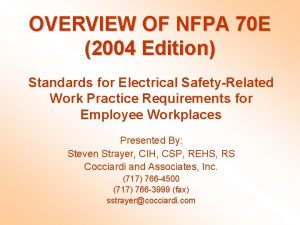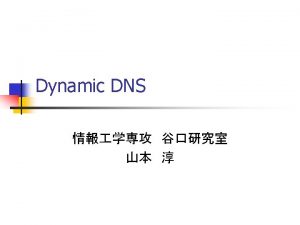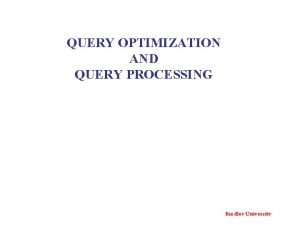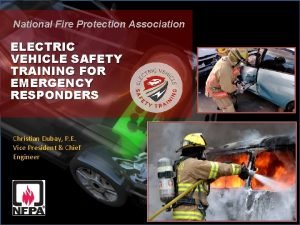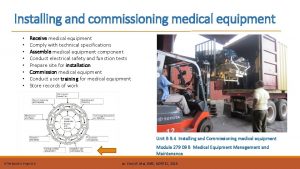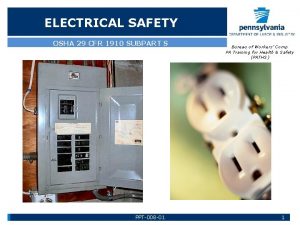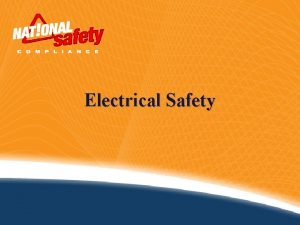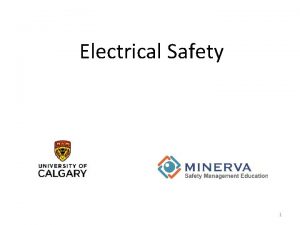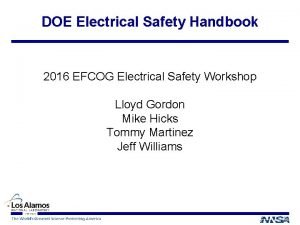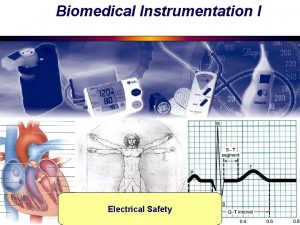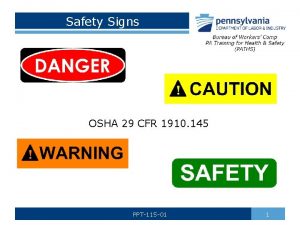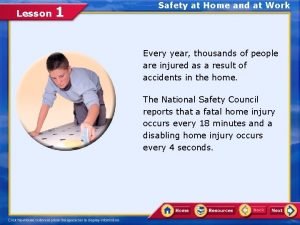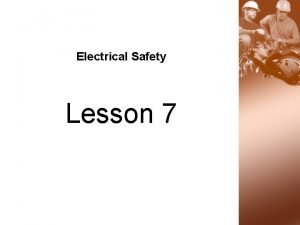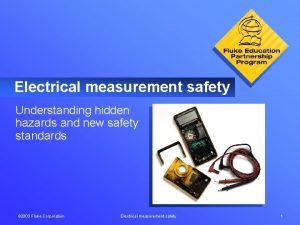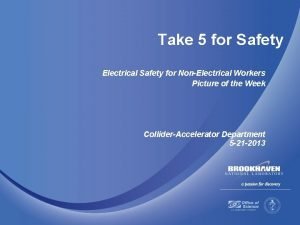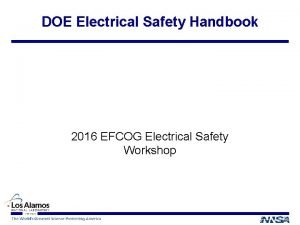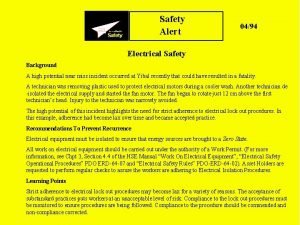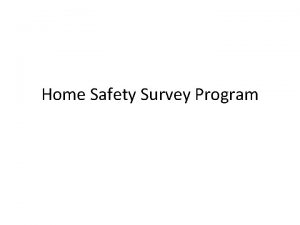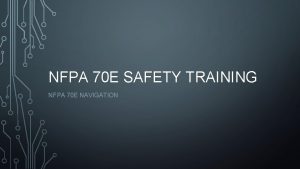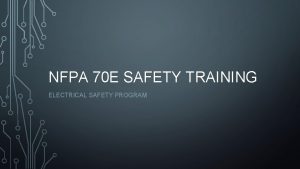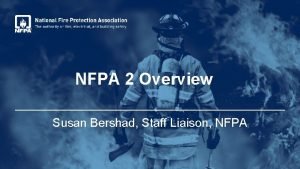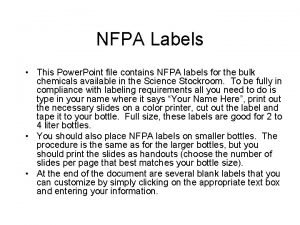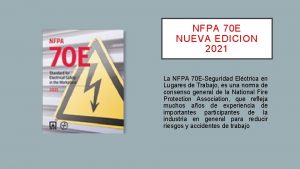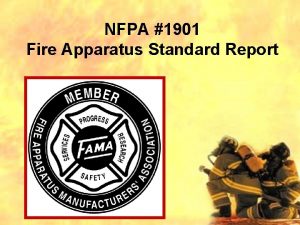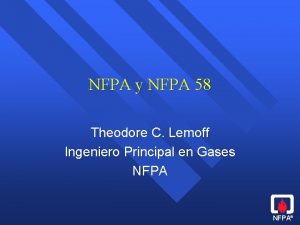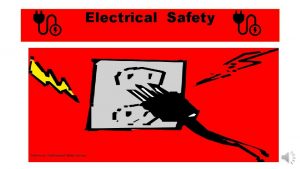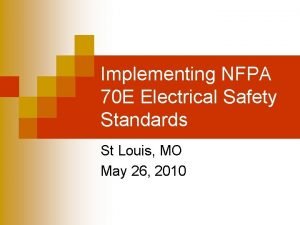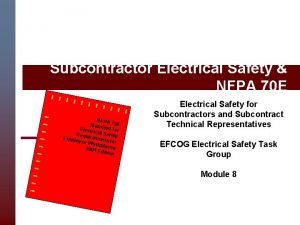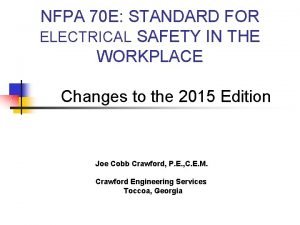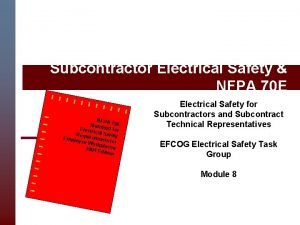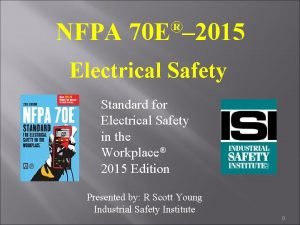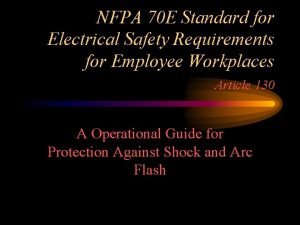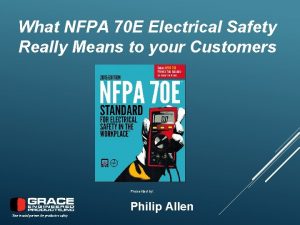ELECTRICAL SAFETY TASK GROUP Query NFPA 70 E





















- Slides: 21

ELECTRICAL SAFETY TASK GROUP Query NFPA 70 E Implementation Benchmark of National Laboratories Greg Christensen, INL Gregory. christensen@inl. gov July 18, 2016

PARTICIPANTS • • • NREL SRS PORTSMOUTH SLAC JEFFERSON HANFORD PNNL ORNL PANTEX INL LLNL ARGONNE • • • WTP SNL BNL LBNL WRPS-RL NETL PPPL LANL Other (3)

PURPOSE Query sites regarding: • NFPA 70 E Implementation • Switching practices • Maintenance of OCPDs

PREVENTING MURPHY’S LAW “If there is any way the technician can do it wrong he will” • A failure will not appear until after final inspection • Hindsight is an exact science - Design error - Faulty install - Inspection does not detect problem - Maintenance performed incorrectly - Performance test not performed correctly - Arc analysis error - Risk assessment error - Sign of impending failure not detected

BACKGROUND NFPA 70 E recognizes arc flash hazards may exist even when equipment is in an enclosed condition. This includes operators whose only interaction is with the equipment in an enclosed condition. There are situations where opening or closing a switch or breaker has been a contributing factor to an arc flash event.

SURVEY QUESTIONS Ø What version of NFPA 70 E are you following? Ø Does your site require PPE for switching of breakers, disconnects and switches? Ø Does your site apply the Task Table 130. 7(C)(9)(a) in 70 E to identify PPE for switching of breakers, disconnects and switches? Ø Is PPE for switching of breakers, disconnects and switches based on an incident energy analysis? Ø Has your site implemented or plan to implement NFPA 70 E 2015? Ø If your site has implemented NFPA 70 E 2015, please explain your site's approach to switching operations.

SURVEY QUESTIONS Ø Does your site have a program to inspect, test and maintain overcurrent circuit protection devices? Ø In regard to normal operations of a breaker, switch, contactor or starter, is your site going to allow operation without PPE? Ø Will there be any exceptions that require the use of PPE based on voltage class or incident energy level? What method/s will be used to verify there is no evidence of impending failure? Ø Have you implemented a documented risk assessment process at your site for electrical work? Who performs the assessment? Ø Have you performed a risk assessment of breaker operations? Any thresholds or criteria that require additional controls?

SURVEY QUESTIONS Ø How does the age and condition of you electrical systems factor into your risk assessment? Ø What tests are performed on Power Breakers and at what intervals? Ø What tests are performed on Molded Case Circuit Breakers and at what intervals? Ø Does your site exclude any voltage or amperage ranges of MCCBs from testing? Ø Should a best practice be developed with regard to criteria for risk assessment and maintenance and testing of Over Current Protection Devices to assist in assigning arc flash controls?

NFPA 70 E VERSION Various versions of NFPA 70 E are implemented Ø 2004 Ø 2009 Ø 2012 Ø 2015 (majority of sites are evaluating and generally have not implemented)

EVALUATING ARC FLASH Ø Some sites have completed incident energy analysis and are labeling equipment to assign PPE based on the Incident Energy Level Ø Some sites rely on the 70 E task tables to assign PPE Ø With the advent of NFPA 70 E 2015, some sites are incorporating aspects of risk analysis into their approach

EVALUATING ARC FLASH (Continued) PPE for breaker and switching operations is required at most of the sites. • Some exceptions are made: • < 125 KVA at ≤ 240 V • < 1. 2 cal/cm 2 lower threshold • < 4 cal/cm 2 lower threshold • > 40 cal/cm 2 is often cited as an upper limit

ASSESSING RISK NFPA 70 E 2015 Employers are responsible for assessing the risk from the arc hazard for employees that interact with electric equipment. Some sites are struggling with the concept of risk analysis and its impact to operations

ASSESSING RISK (Continued) Ø When risk assessment is performed no PPE required if following criteria is met – Installed properly – Maintained properly – Covers in place and secured – Doors closed and secured – No evidence of impending failure The standard does not impose any voltage or incident energy limitations

IMPENDING FAILURE Sites questioned how verification will be performed to ensure: No evidence of impending failure Performance tests detect approximately 2% failure rate

A PERCEIVED ISSUE 25 cal/cm 2 Incident Energy • • Properly installed Properly maintained Cover on and secure no evidence of impending failure Risk = high consequence/low probability = No PPE required per 70 E 2015

RISK Low Probability High Consequence Severity Low Probability Low Consequence High Probability High Consequence High Probability Low Consequence Frequency Is operating overcurrent devices without PPE as safe, or safer than wearing PPE?

PREDICTING THE FUTURE 1967 Apollo Fire “We can solve those problems we think of” 1986 Challenger Disaster “There are enormous differences in the probability of failure …estimates range from 1/100 to 1/100, 000” 2003 Columbia Disaster This problem with foam had been known for years, "Cultural traits and organizational practices detrimental to safety were allowed to develop, " Predicting the future from the past has inherent uncertainty

NFPA 70 E MAINTENANCE Many sites have implemented maintenance programs which are at varying levels of maturity. Ø Maintenance practices and tests performed are widely varied and not consistent. – Funding and resource limitations affect schedules and determine extent of maintenance. – Problems noted with having necessary equipment and expertise to test overcurrent circuit protective devices

NFPA 70 E MAINTENANCE (cont) Ø MCCB maintenance omitted at some sites – Some sites conduct performance testing – Instantaneous testing performed to validate trip time of breaker and arc analysis results. – Overcurrent testing performed at some sites to validate fire prevention equipment protection – External infrared scan on loaded/energized MCCBs; and visual, torque tightness, and mechanical operation on de-energized MCCBs – Breakers considered to be “critical" to arc flash mitigation are prioritized

PROBABILISTIC THEORY Blaise Pascal’s (1623 -1662) Wager A Game is being played. . . where heads or tails will turn up. You must wager it is not optional. Existing in a state of uncertainty, we are forced to choose… Believe Right Wrong Heaven Nothing Not Believe Nothing Hell

CONCLUSIONS The complex would benefit from the development of an EFCOG Best Practice and provide a consistent approach for: • Minimum maintenance practices of overcurrent protection devices • Assessment criteria, limits and thresholds to assist in assigning arc flash controls
 Nfpa 70e 2004 standard for electrical safety
Nfpa 70e 2004 standard for electrical safety Iterative vs recursive dns
Iterative vs recursive dns Query tree and query graph
Query tree and query graph Query tree and query graph
Query tree and query graph Electric vehicle emergency field guide
Electric vehicle emergency field guide Tiered task bias task
Tiered task bias task Electrical safety analyzer
Electrical safety analyzer Osha electrical safety standard 1910
Osha electrical safety standard 1910 Electrical safety introduction
Electrical safety introduction Electrical safety introduction
Electrical safety introduction Doe electrical safety handbook
Doe electrical safety handbook Electrical safety in biomedical instrumentation
Electrical safety in biomedical instrumentation What three elements are required for all electric circuits
What three elements are required for all electric circuits Electrical safety case study
Electrical safety case study Osha safety signs and symbols
Osha safety signs and symbols Lesson 1 electrical safety culture
Lesson 1 electrical safety culture Lesson 7 electrical safety
Lesson 7 electrical safety Electrical measurement safety
Electrical measurement safety Lesson 1: electrical safety culture
Lesson 1: electrical safety culture Take 5 electrical safety
Take 5 electrical safety Doe electrical safety handbook
Doe electrical safety handbook Electrical safety alert
Electrical safety alert
